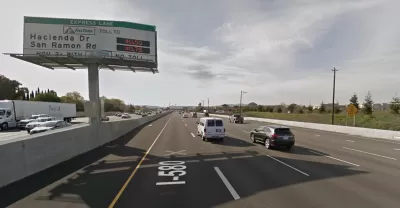Not all of them, just the I-580 lanes. One of the reasons is that most users are actually paying, unlike the other two express lanes where a majority of users are clean-air vehicles or carpools, neither of which pay.

"The Interstate 580 express lanes, which cover 11 miles eastbound and 14 miles westbound between Dublin and Livermore [in Alameda County], have been open a little less than two years," reports Michael Cabanatuan, The Chronicle's transportation reporter, on Dec. 11.
[T]hey’ve already become the regional leader, earning more money and luring in more solo drivers than the other two established express lanes combined. In their first full year [ending Sept. 30, 2017], the I-580 lanes produced more than $9 million in net revenue from tolls.
There are, in fact, three other express lanes in the nine-county Bay Area Express Lanes network, but data from the I-680 Contra Costa lanes, which opened in October, would be premature to evaluate.
- The 14-mile, Alameda County to Santa Clara County, southbound Interstate 680 express lanes over the Sunol Grade, the Bay Area's oldest, opening in September 2010, earned $290,000 in the fiscal year ending June 30, 2017. Construction of the northbound lanes is "anticipated to start early next year."
- The Interstate 880-Highway 237 express lanes, about 2-3 miles within Santa Clara, began operation in March 2013. It recorded $405,000 in net revenue during that time period, reports Cabanatuan.
Why are the I-580 express lanes so popular by comparison?
The I-580 lanes carried 7.9 million vehicles — about 31,000 per weekday — in the 12 months that ended in October. The other two express lanes were used by about 3 million vehicles a year apiece.
But it's not just the sheer numbers of vehicles using the variably-priced lanes, which increase in prices with the level of congestion, but the number of solo-occupant vehicles that pay the toll.
Officials point to I-580’s consistent, and persistent, congestion as a probable reason for those express lanes’ popularity. Compared with the Bay Area’s other established express lanes, the I-580 lanes attract far more solo drivers and fewer carpoolers and clean air vehicles, which travel for free. About 66 percent of the drivers using them are solo occupants, while 27 percent using the I-680 Sunol lanes and 15 percent using the I-880-Highway 237 lanes are driving solo.
[Correspondent's note: Those are incredible figures: only 27 percent and 15 percent of vehicles in the two express lanes paid tolls].
Many of the Bay Area-bound motorists on I-580 drive long commutes to and from the San Joaquin Valley and may be more willing to pay a fee to bust through the backup through the Tri-Valley. For some commuters, the ability to shorten an hour-and-a-half commute by 15 minutes can be enticing enough for them to fork over a couple of bucks to drive the express lanes.
Compared to the $40 morning toll during the first week of operation of the I-66 Express Lanes in Virginia, a couple of bucks is a bargain. And unlike the Bay Area Express Lanes, electric vehicles must pay to use the express lane unless they are carrying at least one passenger.
Revenue is not the goal
While $9 million is a hefty chunk of change, especially in comparison to the unimpressive revenues from the other two express lanes, "The idea is not primarily to make money,” said Randy Rentschler, Director of Legislation & Public Affairs for the Metropolitan Transportation Commission.
“The goal (for I-580) was that we wanted to improve the capacity of the corridor by selling” unused space in the carpool lanes, said Tess Lengyel, deputy executive director of planning and policy for the Alameda County Transportation Commission.
According to the Federal Highway Administration (FHWA), express lanes, called High Occupancy Toll (HOT) Lanes if they allow carpoolers free access, must operate at 45 mph. To ensure they don't become congested, the price rises with the level of congestion.
The high usage of the I-580 Express Lanes doesn't really come as a surprise, though, as last March, after the first year of operation, the Alameda County Transportation Commission had already called them a success based on a careful analysis of the data [pdf], reported Cabanatuan at the time.
FULL STORY: I-580 express lanes take lead in toll revenue

Study: Maui’s Plan to Convert Vacation Rentals to Long-Term Housing Could Cause Nearly $1 Billion Economic Loss
The plan would reduce visitor accommodation by 25,% resulting in 1,900 jobs lost.

North Texas Transit Leaders Tout Benefits of TOD for Growing Region
At a summit focused on transit-oriented development, policymakers discussed how North Texas’ expanded light rail system can serve as a tool for economic growth.

Why Should We Subsidize Public Transportation?
Many public transit agencies face financial stress due to rising costs, declining fare revenue, and declining subsidies. Transit advocates must provide a strong business case for increasing public transit funding.

How to Make US Trains Faster
Changes to boarding platforms and a switch to electric trains could improve U.S. passenger rail service without the added cost of high-speed rail.

Columbia’s Revitalized ‘Loop’ Is a Hub for Local Entrepreneurs
A focus on small businesses is helping a commercial corridor in Columbia, Missouri thrive.

Invasive Insect Threatens Minnesota’s Ash Forests
The Emerald Ash Borer is a rapidly spreading invasive pest threatening Minnesota’s ash trees, and homeowners are encouraged to plant diverse replacement species, avoid moving ash firewood, and monitor for signs of infestation.
Urban Design for Planners 1: Software Tools
This six-course series explores essential urban design concepts using open source software and equips planners with the tools they need to participate fully in the urban design process.
Planning for Universal Design
Learn the tools for implementing Universal Design in planning regulations.
City of Santa Clarita
Ascent Environmental
Institute for Housing and Urban Development Studies (IHS)
City of Grandview
Harvard GSD Executive Education
Toledo-Lucas County Plan Commissions
Salt Lake City
NYU Wagner Graduate School of Public Service


























